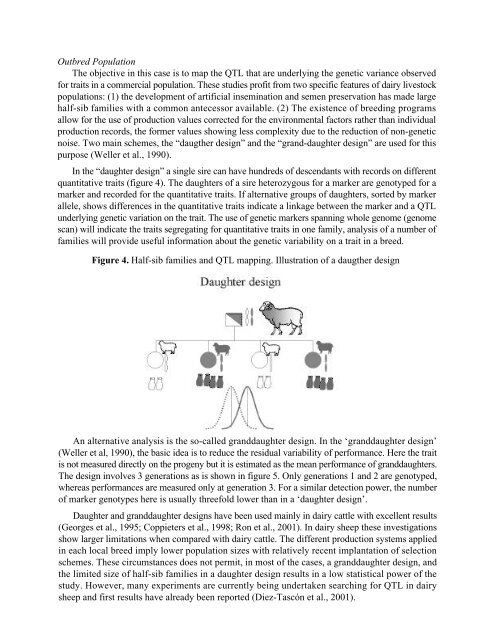Dairy Sheep Symposium - the Department of Animal Sciences ...
Dairy Sheep Symposium - the Department of Animal Sciences ...
Dairy Sheep Symposium - the Department of Animal Sciences ...
Create successful ePaper yourself
Turn your PDF publications into a flip-book with our unique Google optimized e-Paper software.
Outbred Population<br />
The objective in this case is to map <strong>the</strong> QTL that are underlying <strong>the</strong> genetic variance observed<br />
for traits in a commercial population. These studies pr<strong>of</strong>it from two specific features <strong>of</strong> dairy livestock<br />
populations: (1) <strong>the</strong> development <strong>of</strong> artificial insemination and semen preservation has made large<br />
half-sib families with a common antecessor available. (2) The existence <strong>of</strong> breeding programs<br />
allow for <strong>the</strong> use <strong>of</strong> production values corrected for <strong>the</strong> environmental factors ra<strong>the</strong>r than individual<br />
production records, <strong>the</strong> former values showing less complexity due to <strong>the</strong> reduction <strong>of</strong> non-genetic<br />
noise. Two main schemes, <strong>the</strong> “daug<strong>the</strong>r design” and <strong>the</strong> “grand-daughter design” are used for this<br />
purpose (Weller et al., 1990).<br />
In <strong>the</strong> “daughter design” a single sire can have hundreds <strong>of</strong> descendants with records on different<br />
quantitative traits (figure 4). The daughters <strong>of</strong> a sire heterozygous for a marker are genotyped for a<br />
marker and recorded for <strong>the</strong> quantitative traits. If alternative groups <strong>of</strong> daughters, sorted by marker<br />
allele, shows differences in <strong>the</strong> quantitative traits indicate a linkage between <strong>the</strong> marker and a QTL<br />
underlying genetic variation on <strong>the</strong> trait. The use <strong>of</strong> genetic markers spanning whole genome (genome<br />
scan) will indicate <strong>the</strong> traits segregating for quantitative traits in one family, analysis <strong>of</strong> a number <strong>of</strong><br />
families will provide useful information about <strong>the</strong> genetic variability on a trait in a breed.<br />
Figure 4. Half-sib families and QTL mapping. Illustration <strong>of</strong> a daug<strong>the</strong>r design<br />
An alternative analysis is <strong>the</strong> so-called granddaughter design. In <strong>the</strong> ‘granddaughter design’<br />
(Weller et al, 1990), <strong>the</strong> basic idea is to reduce <strong>the</strong> residual variability <strong>of</strong> performance. Here <strong>the</strong> trait<br />
is not measured directly on <strong>the</strong> progeny but it is estimated as <strong>the</strong> mean performance <strong>of</strong> granddaughters.<br />
The design involves 3 generations as is shown in figure 5. Only generations 1 and 2 are genotyped,<br />
whereas performances are measured only at generation 3. For a similar detection power, <strong>the</strong> number<br />
<strong>of</strong> marker genotypes here is usually threefold lower than in a ‘daughter design’.<br />
Daughter and granddaughter designs have been used mainly in dairy cattle with excellent results<br />
(Georges et al., 1995; Coppieters et al., 1998; Ron et al., 2001). In dairy sheep <strong>the</strong>se investigations<br />
show larger limitations when compared with dairy cattle. The different production systems applied<br />
in each local breed imply lower population sizes with relatively recent implantation <strong>of</strong> selection<br />
schemes. These circumstances does not permit, in most <strong>of</strong> <strong>the</strong> cases, a granddaughter design, and<br />
<strong>the</strong> limited size <strong>of</strong> half-sib families in a daughter design results in a low statistical power <strong>of</strong> <strong>the</strong><br />
study. However, many experiments are currently being undertaken searching for QTL in dairy<br />
sheep and first results have already been reported (Diez-Tascón et al., 2001).
















